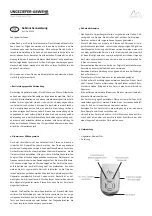
Chapter 6
Monitoring and Troubleshooting
58
Bedrock Secure OSA Remote User Manual - BRDOC020_001
10/11/18
•
CAN bus LEDs indicate that data is being transmitted (left LED) or
received (right LED) over the CAN bus.
•
Ethernet LEDs indicate the status of the Ethernet links for Port A
and Port B and whether there is network traffic occurring over the
Ethernet links. See “Ethernet LEDs” and Table 6-2.
•
The Cyber LED can be used to observe the loading and
authentication of security keys and certificates during startup of an
OSA Remote. During system operation, the Cyber LED indicates
whether or not a connection attempt is successful. See “Cyber LED”,
Table 6-3, and Table 6-4.
•
Channel LEDs indicate the operating status of each OSA Remote I/
O channel. Channel LEDs are color-coded according to the
configured operating mode of each channel. In most cases, solid
colored LEDs indicate normal operation while flashing LEDs
indicate an error condition. See “Channel LEDs” and Table 6-5.
Status LED
The Status LED provides system status including information about the boot
process and authentication. Table 6-1 shows the states of the System Status
LED.
Ethernet LEDs
OSA Remotes have Ethernet Status LEDs for each Ethernet port. These LEDs
indicate the status of the Ethernet link and whether there is network traffic
occurring over the Ethernet link.
During system operation, an Ethernet Status LED is solid yellow when a link is
good and there is no network traffic. An Ethernet Status LED blinks yellow
Table 6-1 System Status LED States
Item No.
LED Color
LED Status
Description
1
None
OFF
No Power
2
Red
Solid
Power on; operating system not yet running or
failed
3
Red
Flashing
While performing a software update,
authentication failed
4
Orange
Solid
Operating system running; loading control
software
5
Green
Solid
Indicates normal operation
6
Green
Flashing
While performing a software update,
authentication is successful
















































